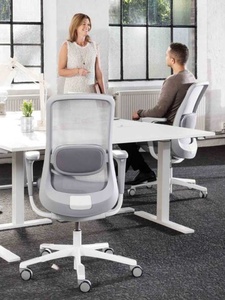The working environment has changed. Today's workplace is a complex and dynamic collection of elements. Today’s workstation is not the standard fixed height table and chair combo. Going forward it looks more and more likely that working from home will become the new norm in some capacity.
With everybody working in a similar workstation with the same equipment it is easier to monitor employee comfort and advise on how best to set up the workstation. Throw in a wide array of different homeworking setups with all kinds of kitchen chairs, laptop stands, ironing board sit-stand desks (yep, very innovative) and take away structured office life a variety of issues can arise!
Ergonomics is the science of designing the job and workplace to fit the worker rather than the other way around. In other words, ergonomics is about eliminating or minimizing physical stressors and environmental factors that adversely affect worker health and comfort. In today’s working world and over the next while effective ergonomics is vital to monitor employee comfort and prevent injuries arising.
When not effectively managed, ergonomics among homeworking employees can spiral and develop into a myriad of headaches for H&S, Occ Health and Facilities. Potential issues include not knowing what equipment employees are using at home, unsure who is at risk of injury, difficulty sourcing effective homeworking equipment, cost of sourcing unsuitable equipment and having trouble making the time to lay out a plan on how to improve current ergonomic processes.
With a growing variety of factors to consider when managing ergonomics within an organisation there’s an increased need for better ways to identify, manage and prevent work related discomfort and injury.
Every organisation’s goal should be to create as time, energy and cost-efficient ergonomic processes as possible. This article will give you some actionable tips to help refine your ergonomic processes and guidance on how best to manage the ergonomics in your organisation once you’ve developed a strong foundation.
Step 1 - Educate Employees on Ergonomics
Workplace Ergonomics is about designing the workstation and tasks to fit the capabilities of the employee. In today’s working world there has been a sharp influx in homeworking, this is likely to have a lasting effect with organisations opting to implement long term homeworking policies. Homeworking introduces several variables to the equation and makes it more difficult for H&S or Facilities Managers to ensure employees are working in comfort and any injuries are managed effectively.
What should your goals for ergonomics be? On a fundamental level, without getting into the nitty gritty of different industry demands, the goals of ergonomics should be to provide a positive working environment in which the design of equipment, work layouts and work environment matches the capabilities of people so they can lead healthy and productive lives.
Like with many things it’s difficult to create buy in from people if they don’t understand how and why they are doing something. Creating a healthy foundation by educating all employees on correct setup and working habits is vital to ensure minimal issues will arise further down the line. See link to ‘Ultimate Guide to Homeworking E-Book’ to educate staff on best practice of setting themselves up at home.
Ergonomics improves human performance. If people perform well, an organisation as a whole will perform well. If people perform poorly, long-term success is more difficult to achieve. With higher rates of homeworking and given the fact that homeworking ergonomics will be difficult to monitor it’s vital for long term success that a plan is put in place to manage ergonomics.
Step 2 - Support employees working at home
Maintaining employee comfort at home can be difficult. Giving people the information and guidance, they need to set themselves up is a great starting point. To continue to adhere to this guidance over time regular support is needed. Frequent contact will help ensure employees are always conscious of their setup and habits by keeping ergonomics front of mind.
Work related injuries do not happen overnight. You most likely will not require physiotherapy treatment after working on a laptop for 1 hour. Likewise, exposure to ergonomic guidance once off is unlikely to be super effective!
When it comes to ergonomics ‘Out of sight out of mind’ can often ring through. Keeping awareness high by sending employees working at home regular info like the ‘posture watch’ posters around the workplace will help keep ergonomics on everybody’s mind.
Aside from ergonomics there are other areas you can support your colleagues during this time.
- Encourage regular Zoom catch up calls among work friends or teammates to replace the social aspect of office life
- Encourage use of your organisation’s wellbeing resources
- Provide weekly Webinars for health-related fields
- Encourage a work-life balance
- Send a weekly newsletter with Health Tips
- Run a weekly step counting competition between teams
Step 3 - Identify Your Ergonomic Challenges
The risk of a forced move to homeworking is many employees will not have been setup to work from home. Although effort may have been made to make home working environments more suitable, many employees will be working in discomfort, with injuries or at risk of developing work-related injuries!
To minimize the risk of issues going under the radar it’s important to put a plan in place to identify the challenges currently aced by your colleagues and where possible, resolve these issues.
Try this effective, three-step process which will help you identify and address ergonomic challenges employees encounter while working from home.
1. Provide Education and ongoing Training
As discussed above, Education and regular support are vital to empower employees to set themselves up effectively at the workstation and to encourage them to be conscious of their working posture. This step has the potential to provide an excellent foundation for effectively managing employee discomfort.
2. Employee Self-Assessment
Have Employees conduct a self-assessment of their workstation. This can be done differently using workstation questionnaires or ergonomic software.
A) Workstation Questionnaires
This is a cheap method of gaining an understanding of the home workstations. It involves H&S putting together a series of questions for employees to fill out regarding their home-workstation and how it is setup. For large numbers of employees, it can be exceedingly difficult and time consuming to filter through all questionnaires and decide who is at high, medium, or low risk of work-related injury. There can also be a lack of depth to the questions and self-assessment resulting in issues going under the radar which in time may result in the cost of resolving these issues.
B) Use an Ergonomic Self-Assessment Software
This option can streamline the risk assessment process by providing tailored education for each employee on setting up their workstation along with an online self-assessment which can identify those at high, medium, and low risk of work-related injury. The software enables an organisation to prioritize resolving high priority cases quickly and efficiently. If time is a major constraint, then the ergonomic self-assessment software can be a brilliant option. The software also provides organisations with a paper trail of steps taken to minimize the risk of employee discomfort or injury. As a whole, self-assessment software can enable management to effectively monitor, identify and action the many variables employees encounter at home.
3. Remote Ergonomic Assessment for specific cases
Once you have identified what issues need addressing it is important to prioritize employees that are working in pain or at a higher risk of injury. Normally an in person Detailed Assessment would be the best option but in the current environment we are forced to think outside the box. A remote assessment via Skype or Zoom call is the best option. Prior to the assessment the employee fills in a workstation questionnaire, takes pictures of their workstation and returns all to the Assessor. Following this a video call is arranged where an Ergonomic Consultant can review the employee’s working posture and can advise how best to set up their workstation.
Step 4 - Resolve Identified Issues
A variety of issues can arise in the workplace and even more at home so arming yourself with a selection of different tried and trusted ergonomic solutions is essential. With the vast array of office products, equipment, and furniture available today (much of which is labelled "ergonomic"), how do you choose which are most appropriate for the task at hand? Refer to this partial list, outlining some key features you will need when sourcing common workstation items:
Sourcing Homeworking Equipment:
Chairs
For homeworkers chair options will vary from a standard kitchen chair to the usual office chair. To comply with HSA regulations the backrest must be height and tilt adjustable. Backrest should have adjustable tension so user can alternate working position with ease. There are a variety of mechanisms on chairs that have differing effects in managing discomfort. The Synchro mechanism is a popular option for homeworking, as it provides lots of support to the user while the price point tends to be quite reasonable.
Desks
Many people will not have a suitable workstation at home. Especially if there is more than one person working at home. For these cases ensure the size of the tabletop matches the needs of the employees. Ensure if employees are taller or shorter than normal there is some flexibility to adjust desk height.
Laptop accessories
When working at home off a laptop, use a laptop stand (so the top of the screen is at eye level), a separate mouse, and a keyboard for extended periods of computer use. If you have a monitor at home, then use a monitor riser or books to elevate the monitor so the top of the screen is at eye level.
Ergonomic Mice and Keyboard
Should enable user to work with hands in a more natural position. For the keyboard a split and angle adjustment are essential to reduce the wrist or forearm discomfort. A mouse that fits the user’s hand effortlessly should be sourced.
If you have questions on other pieces of homeworking equipment that you or your team require please contact sales@kos.ie.
Although not a complete list it gives an idea of what to look for. Having an approved equipment list of ergonomic equipment also ensures that all departments are sourcing tried and trusted solutions for their homeworking employees. At KOS we work with organisations to develop these lists saving time and future costs when ineffective solutions are sourced.
KOS Ergonomics are a team of ergonomic consultants who have been helping Health and Safety managers develop and manage their ergonomic processes for over 20 years. Over the years we have seen and helped resolve a variety of injuries ranging from a dull ache in the lower back to helping an employee return to work following surgery with confidence.
We have helped navigate the obstacles and frustrations of looking after large numbers of people’s comfort by providing a range of services and equipment. We’ve introduced an ergonomic management software to help organisations manage the move to homeworking effectively and efficiently.
Our Consultants are ergonomic specialists, with backgrounds in physical sciences like physiotherapy, health and performance science and of course ergonomics, are trained to carry out assessments, recommend specific equipment and consult on how best to manage ergonomic processes to make the office healthier.
When it comes to managing ergonomics at home, we know there isn’t a one size fits all approach.
We are now offering FREE Homeworking Ergonomic Consultations to help manage discomfort for employees working at home in a cost and time efficient manner.
During these consultations we are demonstrating our Ergonomic Management Software, discuss remote assessment options for staff in pain and review homeworking equipment.
We can also discuss what similar organisations are doing to effectively manage employee comfort during this time!
To arrange for your Ergonomic Consultation email sales@kos.ie or call 01 6110 200.
References:
- Breaking up workplace sitting time with intermittent standing bouts improves fatigue and musculoskeletal discomfort in overweight/obese office workers.
- Thorp AA1, Kingwell BA2, Owen N3, Dunstan DW4.
- http://www.healthyireland.ie/accessibility/healthy-ireland-survey/
- http://www.getbritainstanding.org/research.php
- http://www.healthyireland.ie/irelands-first-ever-national-physical-activity-plan-is-launched-by-government
















